Portfolio
A Sample List of Accomplishments
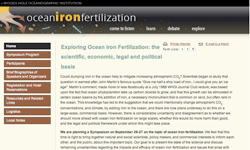 Ocean Iron Fertilization Symposium, June 2007
Ocean Iron Fertilization Symposium, June 2007
This is an example of working within the WHOI content management system (CMS) to provide the client a unique banner and color scheme while retaining the Institution’s Web site look and feel for overall consistency. A uniform look and feel promotes the Institution’s Web credibility, part of the standards and guidelines put forth by the Stanford University Web Credibility Project (http://credibility.stanford.edu). (PI: Ken Buesseler)
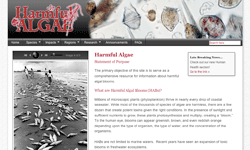 Harmful Algae Page, June 2007
Harmful Algae Page, June 2007
Although not yet live, I worked with the WHOI Web Group and CIS to develop a template for the WHOI CMS that was free of table layouts in order to provide easier templating for future unique Web sites. By integrating WHOI’s CMS with Cascading Style Sheets (CSS) for layout, the Web Group will now be better positioned to provide custom templates for the WHOI community, as well as general templates that include both fixed and fluid layouts. (PI: Don Anderson)
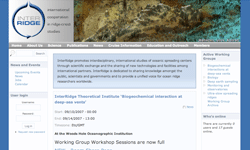 InterRidge, May 2007
InterRidge, May 2007
WHOI inherited a frame-based Web site with a flattened database from the previous host of the InterRidge program and needed to bring it into a more dynamic site with a relational membership and cruise database that could be easily maintained by the client. The open source CMS Drupal was chosen for this site. This direction was taken because InterRidge stays with WHOI for three years, so the site will need to be transitioned easily to the next host country, free from the propriety issues that may encountered using the WHOI CMS. Once Drupal was installed on our server, I designed and implemented a new user interface design for InterRidge using the open source CMS Drupal, with technical support from Andy Maffei and Julie Allen. Using CSS, I designed new templates in Drupal. The site includes commenting abilities which allow users to express their thoughts on the site, controlled by the InterRidge coordinator. The Web site continues to evolve, with the membership and cruise databases currently being tested, and further modules include a language translation tool so that international members may better communicate with their colleagues. (PI: Jian Lin)
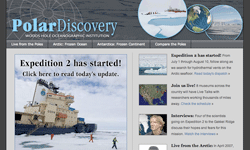 Polar Discovery, January 2007
Polar Discovery, January 2007
In 2006, WHOI received a grant to bring polar research to the general public through a Web site and live talks with partnered museums. I was given the responsibility to design and implement a Web site that conveyed the excitement of research at the Poles. As manager of the Web site, I developed the site’s architecture with the target audience in mind, which is stronger in visuals and multimedia than previous expedition sites I have done. It was during this time that I found several methods to display photo essays and videos using a technology of Flash driven by XML files. The daily journals use this technology, while the videos and podcasts use Flash. In recent months, the use of Flash technology for videos has been pervasive across the Internet because of its cross-platform and browser compatibility. For the marketing aspect, I uploaded podcasts of WHOI scientists explaining their research and the Poles to both YouTube and Google Videos. It was my intention to raise the awareness of WHOI as many of our contemporaries, including Scripps, have already done. (PI: Chris Linder)
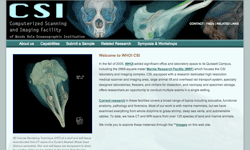 Computerized Scanning and Imaging Facility (CSI), December 2006
Computerized Scanning and Imaging Facility (CSI), December 2006
When the Marine Research Facility (MRF) opened, it provided the CSI laboratory and imaging complex with a high resolution medical scanner and imaging area, large animal lift and overhead rail transport system, specially designed laboratories, freezers, and chillers for dissection, and necropsy and specimen storage. This larger facility allowed the CSI laboratory to provide a broader range of resources and services to both internal and external scanning and imaging clients. CSI needed a Web site that would not only showcase the capabilities of this laboratory to prospective clients, but also provide an easy way for clients to order, pay, and view results for the services they require. After providing an estimate of costs that outlined the steps involved with creating this web site, we began the process. After the architecture was finalized, I provided several proofs to the CSI lab. Once it was established that the Lab would be able to maintain the site themselves, I produced and implemented the site using Dreamweaver templates and CSS. Once the site was built, I trained the lab personnel to update the site. Still pending is the capability to provide clients a way to submit credit card information with their requests. It is my hope that this pioneering endeavor will open the door to many more groups across the Institution to be able to provide services conveniently outside the WHOI community. (PI: Darlene Ketten)
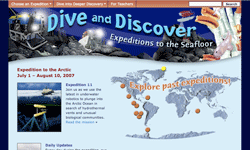 Dive and Discover, February 2006
Dive and Discover, February 2006
After several years of success, the Dive and Discover Web site needed to be updated from the constraint of a fixed browser window and frames, as well as new architecture to reflect current user trends. After submitting a detailed proposal and estimate of costs, I was charged with managing the process of updating and implementing the new site. The first task was to create and administer a survey to the current user base. Once the survey was conducted and analyzed, a new architecture was designed based on user feedback and best practices. The wireframe of the architecture was then user tested and the resulting feedback produced the final architecture. The actual design of the site was based on the target audience of middle school children. Bold, multi-colored illustrations and engaging fonts were used to attract both a young audience, but at the same time not too juvenile as to repel an older audience from exploring the site. (PI: Dan Fornari, Susan Humphris)
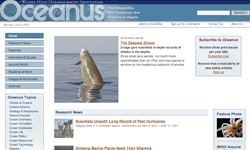 Oceanus Magazine, January 2005
Oceanus Magazine, January 2005
Oceanus Magazine has been representing the Institution with highlights of research and researchers through news, features, and interviews since 1952. With a print circulation of around 2000, it became clear that the Internet could bring a new and larger audience to the Institution, as well as providing an easy way for WHOI scientists to be able to share research stories with colleagues. The managing editor, Lonny Lippsett, assigned the process of bringing the magazine online to me. I began by conducting a competitive analysis of other sites that had both print and web-based publications. I compiled this data, and produced a wireframe, and after two rounds of user testing, the navigation was complete. The initial design of the site was intended to be simple, clean, and easy to understand so that the content—rather than the design—would be the most significant and therefore more accessible to the user. Subsequent redesigns have included additional magazine and news functionality, including email to a friend, user-based text size adjustment, and email alerts. (PI: Lonny Lippsett)
Other Web sites:
Woods Hole Oceanographic Institution (base design): http://www.whoi.edu
WHOI Site Builder Lite: http://www.whoi.edu
Director of Research: http://www.whoi.edu/administration/dirres/
Grant and Contract Services: http://www.whoi.edu/administration/g_cs/
Graphic Services: http://www.whoi.edu/graphics
CICOR: http://www.whoi.edu/cicor/
OceanSITES: http://www.oceansites.org/
WHOI 75th Anniversary: http://www.whoi.edu/75th/
Web sites in progress
MIT/WHOI Alumni Web site with interactive database and news section (Julia Westwater)
Coastal Web site (Britt Raubenheimer)
Marine Metadata Interoperabiity Project (Multi-institutional, John Graybeal, MBARI)
